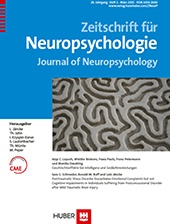Entwicklung von drei Parallelversionen des Kategorienwechsels des Regensburger Wortflüssigkeitstests
Abstract
Eine Vielzahl psychischer Erkrankungen ist von Defiziten der Exekutivfunktionen begleitet, die häufig durch Wortflüssigkeitsaufgaben erfasst werden. Dabei kommen überwiegend einfache Wortflüssigkeitsaufgaben zum Einsatz, obwohl Aufgaben zum Kategorienwechsel höhere Anforderungen an die Exekutivfunktionen stellen. Untertests zum Kategorienwechsel enthält bisher lediglich der Regensburger Wortflüssigkeitstest. Um den Kategorienwechsel in wiederholten Messungen der Testleistung einsetzen zu können, haben wir drei neue Versionen der Untertests zum phonematischen und semantischen Kategorienwechsel des Regensburger Wortflüssigkeitstest entwickelt und an 58 gesunden Probanden validiert. Die Ergebnisse zeigten, dass die Anzahl der generierten Wörter in allen fünf Versionen gleich und die Paralleltestreliabilität mit Werten zwischen 0.82 und 0.91 hoch war. Die fünf Versionen des phonematischen und semantischen Kategorienwechsels können in einer Vielzahl klinischer und wissenschaftlicher Settings eingesetzt werden.
A variety of psychiatric disorders are accompanied by pronounced executive dysfunctions. Verbal fluency tests are often used to assess these dysfunctions. The majority of studies did not include alternating verbal fluency task, although they make greater demands on executive processes than simple verbal fluency tasks. Up to date, the Regensburger Wortflüssigkeitstest is the only test procedure which includes alternating verbal fluency tasks, but the subtests only exist in two alternate forms. In order to provide a set of alternating verbal fluency tasks, we developed three new alternate forms of the alternating verbal fluency subtests of the Regensburger Wortflüssigkeitstest. Fifty-eight healthy subjects were included in the study. The mean number of correct words did not differ between the five versions of the phonemic and semantic alternating fluency subtests. The herein described versions of the alternating verbal fluency tasks are suitable for the use in a variety of clinical or research settings.
Literatur
(2001). Qualitative analysis of verbal fluency output: review and comparison of several scoring methods. Assessment, 8, 323 – 336.
(2006). Study design in fMRI: Basic principles. Brain and Cognition, 60, 220 – 232.
(2002). Psychologische Diagnostik und Intervention. Heidelberg: Springer Verlag.
(2006). Cognitive testing toward the future: The example of semantic verbal fluency (ANIMALS). International Journal of Psychology, 41, 324 – 332.
(Hrsg) (2000). RWT – Regensburger Wortflüssigkeits-Test: Handanweisung. Göttingen: Hogrefe.
(1998). Category and letter fluency in highly educated older adults. The Clinical Neuropsychologist, 12, 330 – 338.
(2003). Comparison of block and event-related fMRI designs in evaluating the word-frequency effect. Human Brain Mapping, 18, 186 – 193.
(1984). Cognitive and mororshifting aptitude disorder in Parkinson’s disease. Journal of Neurology, Neurosurgery and Psychiatry, 47, 443 – 453.
(1993). Alternating fluency in Parkinson′s disease. Brain, 116, 887 – 902.
(1996). Trail making test: normative values from 287 normal adult controls. Italian Journal of Neurological Science, 17, 305 – 309.
(2002). Posterior parietal cortex is implicated in continuous switching between verbal fluency tasks: an fMRI study with clinical implications. Brain, 125, 1024 – 1038.
(2005). A meta-analytic review of verbal fluency deficits in depression. Journal of Clinical and Experimental Neuropsychology, 27, 78 – 101.
(2006). Covariates of production and perseveration on tests of phonemic, semantic and alternating fluency in normal aging. Aging, Neuropsychology, and Cognition, 13, 529 – 551.
(2006). Role of the left inferior frontal gyrus in covet word retrieval: neural correlates of switching during verbal fluency. Neuropsychologia, 44, 2547 – 2557.
(2007). The elusive nature of executive functions: a review of our current understanding. Neuropsychological Review, 17, 213 – 233.
(2004). Semantic and phonological processing in illiteracy. Journal of the International Neuropsychological Society, 10, 818 – 827.
(1969). Mehrfachwahl-Wortschatz-Intelligenztest (MWT-B). Erlangen: Perimed Fachbuch Verlagsgesellschaft mbH.
(1995). Neuropsychological Assessment (3. Aufl.). New York: Oxford University Press.
(2000). Comparison of rhyming and word generation with fMRI. Human Brain Mapping, 10, 99 – 106.
(2006). Cross-linguistic meta-analysis of the phonological fluency: Normal performance across cultures. International Journal of Psychology, 1, 342 – 347.
(2011). Die leichte kognitive Beeinträchtigung. Stuttgart: Schattauer Verlag.
(2009). Exekutivfunktionen in der Aphasietherapie. Forum Logopädie, 23, 6 – 9.
(2013). Performance on five verbal fluency tests in a healthy, elderly Danish sample. Aging, Neuropsychology, and Cognition, 20, 22 – 33.
(1999). Normative data stratified by age and education for two measures of verbal fluency: FAS and animal naming. Archives of Clinical Neuropsychology, 14, 167 – 177.
(2004) Trail Making Test A and B: normative data stratified by age and education. Archives of Clinical Neuropsychology, 19, 203 – 214.
(2006). Normative data for the animal, profession and letter M naming verbal fluency tests for Dutch speaking participants and the effects of age, education and sex. Journal of the International Neuropsychological Society, 12, 80 – 89.
(2007). Exekutive Funktionen bei depressiven Patienten. Nervenarzt, 78, 628 – 640.
(1997). Stamm Screening Questionaire – Diagnostic Expert system for mental disorders. Frankfurt: Pearson Assessment.
(1999). A comparison of phonemic, semantic and alternating word fluency in Parkinson′s disease. Archives of Clinical Neuropsychology, 14, 255 – 264.



